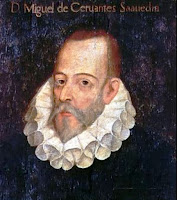Literature / Writers Datebook: December 16
Brief biography of English writer Jane
Austen, considered the first outstanding woman novelist. Best-known for her
novels Pride and Prejudice and Emma. Her novels have been adapted to film and television series.
The commentary
of English novelist Jane Austen bites and her masterful use of indirect
discourse and irony makes her one of the most influential and respected novelists
of the early 19th century. Austen's stories
are subtle as she tells about young, well-bred heroines, injecting the snobbery
and the manners of their country-house families. In Pride and Prejudice, a young man and woman begin by disliking
each other but at last fall in love. In Emma,
a snobbish young woman develops into someone capable of feeling and love.
Early Life
Jane Austen was
born in Steventon, Hampshire, on December 16, 1775, one of two daughters of the
Rev. George Austen and his wife Cassandra (née Leigh). Her brothers James and
Henry followed in the path of their father and joined the clergy (the latter
towards the end of his life after a successful career as a banker), while
Francis and Charles both pursued naval careers.
Close Family
Relationship
She had a
sister, Cassandra, with whom she maintained a close relationship throughout her
life. The abundant correspondence between the sisters provides historians with
the greatest insight into Austen's past. The only undisputed portrait of Jane
Austen is a rudimentary coloured sketch
done by Cassandra.
Education
In 1783, she was
educated briefly by a relative in Oxford, then
in Southampton, and finally in 1785–1786, she attended the Reading Ladies
boarding school in Reading, Berkshire.
This uncommonly advanced level of education may have contributed to her early alignment
towards writing, and she began her first novel in 1789. The Austen family also
often enacted plays, which gave Jane an opportunity to present her stories.
Family Move to Bath
Austen's life
was even less eventful than those of her characters. In 1801 the family moved
to the socially esteemed spa city of Bath,
which provides the setting for many of her novels. The following year, she received
a marriage proposal from a wealthy man Harris Bigg-Wither, almost six years her
junior. She refused him.
Move to Southampton
After the death
of her father in 1805, Austen, her sister and her mother lived in Southampton with her brother Frank and his family for
several years before moving to Chawton in 1809. Here her wealthy brother Edward
had an estate with a cottage, where he allowed his mother and sisters to live.
This home is now a museum and is a popular site for tourists and literary
pilgrims alike.
Final Years
It was in Chawton
that she wrote her later novels. In 1816, she began to suffer from ill health
and moved to Winchester
to be closer to her doctor. It is now thought by some that she may have
suffered from Addison's disease, a failure of the adrenal glands that was often
caused by tuberculosis. At that time the disease was not known and unnamed. Her
condition became increasingly unstable. She died aged 41, on July 18, 1817, and
was buried in Winchester Cathedral.
Film Adaptation
of Austen's Novels
Austen's novels
have been adapted in a great number of film and television series, varying
greatly in their faithfulness to the originals.
Pride and Prejudice has
been the most reproduced of her works, with six films, the 2005 adaptation
directed by Joe Wright, starring Keira Knightley (Elizabeth Bennett), Donald
Sutherland (Mr. Bennett), Matthew Macfadyen (Mr. Darcy), and Dame Judi Dench
(Lady Catherine de Bourgh), as well as the 2004 Hollywood adaptation Pride & Prejudice.
There is also a
1940 film version of the novel starring Laurence Oliver as Mr. Darcy, and Greer
Garson as Elizabeth Bennett. Previously, there were five television series
produced by the BBC, the most noteworthy being the well-loved 1995 version,
starring Colin Firth and Jennifer Ehle.
Emma has been
adapted on television several times, first in 1948. Recent versions include a
1972 British television version, the 1996 film Emma, with Gwyneth Paltrow and Jeremy Northam, and also in 1996
on British television with Kate Beckinsale.
Sense and Sensibility has been
made into four films including the 1995 version, from a screenplay adapted by
Emma Thompson (who won the Academy Award for Best Adapted Screenplay), directed
by Ang Lee and starred Thompson and Kate Winslet.
Persuasion has been adapted into two television series and one feature
film. Mansfield Park and Northanger Abbey have also been made
into films.
Novels by Jane Austen
Sense and Sensibility, 1811
Pride and Prejudice, 1813
Mansfield Park, 1814
Emma, 1815
Northanger Abbey, 1817 (posthumous)
Persuasion, 1817 (posthumous)
Love and Friendship, 1922 (posthumous)
Photo Credit:
Jane Austen. Wikimedia Commons / Public Domain. (Portrait, c. 1810, in watercolour and pencil.)
Resources:
Cambridge Guide to Literature in English by
Ian Ousby, Cambridge
Univ. Press, 1993
Chambers Biographical Dictionary, edited by Una
McGovern, Edinburgh.
Chambers Harrap, 2002
Larousse Dictionary of Writers, edited by
Rosemary Goring. New York:
Larousse, 1994
(c) December 2009. Tel. Inspired Pen Web. All rights reserved.
 The theremin musical instrument is best known for creating the spooky or eerie sounds heard in many 1950s science fiction films. It is a unique instrument being "played" without being touched. This electronic musical instrument is named after its Russian inventor and physicist, Professor Leon Theremin, who patented the device in 1918 (or 1919).
The theremin musical instrument is best known for creating the spooky or eerie sounds heard in many 1950s science fiction films. It is a unique instrument being "played" without being touched. This electronic musical instrument is named after its Russian inventor and physicist, Professor Leon Theremin, who patented the device in 1918 (or 1919).








.jpg)



